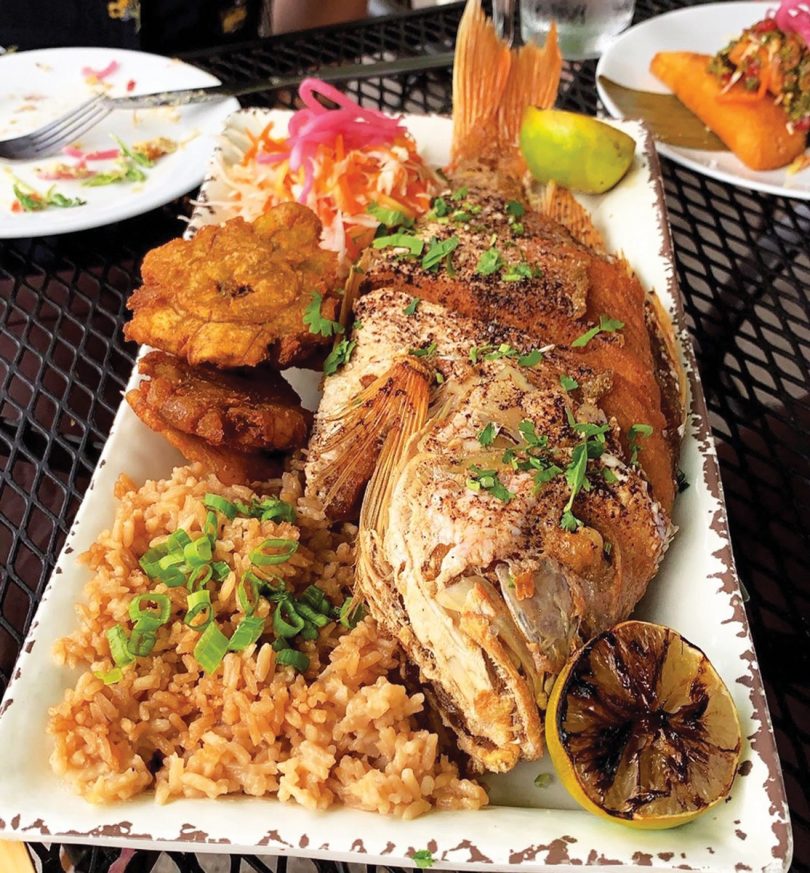Edgar Caro did not fully understand his success until he rifled through his grandmother’s cookbooks. He had taken a risk, he said, when he opened Baru 12 years ago, serving Latin Caribbean food at a time when New Orleans was saturated with Creole and Italian. But it worked. “When I really go to old books that my grandma left me and I see the technique of how something is done, it’s like, oh my god, they’re doing an étouffée but it’s not crawfish because we don’t grow crawfish [in Colombia], but it’s étouffée,” Caro said.
At Baru, Caro was simply cooking the food he knew, plucking the empanadas and favorite dry-fried fish he ordered from a beach-side shack out of his childhood in Cartagena. In doing so, he unknowingly tapped into the same undercurrent of the New Orleans cultural consciousness that has fueled the success of restaurants like Compère Lapin, Fritai, 14 Parishes, Boswell’s Jamaican Grill, Queen Trini Lisa and more. As Joel Hitchcock-Tilton, founder of the NOLA Caribbean Experience festival, puts it, “New Orleans is Caribbean.”
New Orleans’ Caribbean identity often plays second fiddle to that of its colonizers, the French and the Spanish, both of whom also occupied Caribbean islands. The Caribbean, however, is no less present.
Indeed, many of the Caribbean chefs like Caro, Lisa Nelson (a native of Trinidad and Tobago who cooks as Queen Trini Lisa), and Charly Pierre, a first generation Haitian-American who owns Fritai, were surprised to discover the similarities between their new homes and their old. “Even the smell of the French Quarter reminds me of Port of Spain, our capital,” Nelson said.
In 1809, the decades of fighting—that constituted the Haitian revolution, the most successful rebellion led by enslaved persons in the Americas—came to an end and set off a wave of emigration from that island country. Ten-thousand people, equal parts people of European descent, enslaved people and free people of color, arrived in New Orleans, doubling the city’s population.
This influx came after New Orleans had suffered two Great Fires in 1788 and 1794, collectively razing 1,000 buildings. The city was rebuilding and Caribbean culture embedded itself into the scaffolding. Voodoo, shotgun houses, second lines—those cultural emblems that New Orleanians treasure about their city, have their roots in Haiti. The same is true for food.
As the chefs described, Caribbean and New Orleans cuisines share many of the same staples: rice, beans, seafood, greens, hot spices and corn meal, though the way they are prepared varies from nation to nation.
“It’s stick-to-your-ribs food so very similar to New Orleans style cuisine,” Pierre said of Haitian cuisine. “We have our version of red beans and rice. Very similar, but instead we just puree our red beans all the way. We have a gumbo that’s very similar but we don’t add filé to it.”
To Nelson, New Orleans’ jambalaya looks like pelau, a Trinidadian rice dish with meat, pigeon peas and vegetables. To Caro, it looks like Colombian paella. Corn meal used for grits in New Orleans, in Caro’s hands, is turned into empanadas.
The spices, too, vary. Caribbean food relies more on scotch bonnet peppers that, when freshly cracked, “smell like Haiti when you first wake up in the morning,” Pierre said. New Orleans uses cayenne pepper and bell pepper, said Ashley Jonique, private chef and owner of the former DBLBLK Café. The Caribbean also has an East Indian influence that its northern counterpart lacks, adapting curries from the indentured servants Europeans brought over from India.
The rise in Caribbean food in New Orleans is more of a re-discovery, a journey into New Orleans’s culinary future through its past.
Fusion restaurants like Pierre’s Fritai are gaining popularity and national notoriety. Fritai’s signature dish is a plantain sandwich—two crispy, flat buns of fried plantain with either tofu or pork squeezed between them and dressed with avocado, mango sauce and pickliz (a Haitian pickled vegetable relish).
Baru promotes itself as Latin Caribbean, and Nina Compton, a chef from St. Lucia, was named Best Chef: South by the James Beard for her work at her French Caribbean restaurant Compère Lapin. Compton’s menu at Compère Lapin includes Caribbean classics like curried goat and jerk chicken.
More traditional restaurants have equally gained traction. Nelson only started selling her food after customers smelled her cooking it in her corner store and were infatuated by the scent. She now runs a pop-up that can be found at festivals and every Wednesday at Portside Lounge.
Likewise, 14 Parishes, Johnny’s Jamaican Grill and Island Paradise Restaurant & Grill all provide a delectable sampling of Caribbean cuisine. Boswell’s Jamaican Grill has an eight- dollar lunch buffet with a robust sampling of rice, veggies, and curried and jerked meats that all taste like the hot, refreshing delight of a humid breeze.
Restaurants continue to open around the city. 14 Parishes has expanded to two locations and Hitchcock-Tilton’s NOLA Caribbean Fest is going into its third year.
“New Orleans and Caribbean food is always going to have this love affair,” Caro said.





